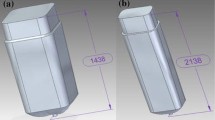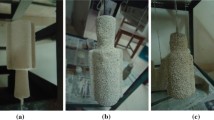Abstract
Ceramic shell mould plays a key role in achieving dimensional accuracy and quality of casting. This work investigates the effect of mould parameters such as silica concentration, filler to binder ratio and the number of secondary coats on mould properties, namely modulus of rupture, adjusted fracture load, and permeability. Experimental results report that enrichment in silica results in drastic growth in adjusted fracture load with a small increase in modulus of rupture and no change in permeability. Improvement in filler to binder ratio causes a significant increase in the adjusted fracture load and modulus of rupture with moderate decrease in permeability. An increase in number of ceramic coats increases the adjusted fracture load significantly and reduces permeability moderately. Impact of the adjusted fracture load on casting shrinkage has been studied by conducting various casting trials. Adjusted fracture load above 315 N is preferred which corresponds to 25–30% silica, filler to binder ratio of 1.25 and number of secondary coats as six to eight for reduced shrinkage variation.















Similar content being viewed by others
References
Pattnaik S, Karunakar D B, and Jha, P K, J Mater Process Technol 212 (2012) 2332.
Carty W M, Lee H, Reeves E, Ormond P, and Mauzy R, AFS Trans117 (2009) 403.
Bundy J and Viswanathan S, Int J Metal Cast3 (2009) 27.
Kline D M, Lekakh S N, and Richards V L, Trans Am Foundry Soc118 (2010) 10.
Yuan C and Jones S, J Eur Ceram Soc23 (2003) 399.
Watts C H, U.S. Patent. No. 3,165,799. Washington, DC: U.S. Patent and Trademark Office (1965).
Lü K, Liu X D, Du Z X, and Li Y F, China Foundry13 (2016) 211.
Nadolski M, Konopka Z, Łągiewka M, and Zyska Arch Foundry Eng8 (2008) 149.
Pattnaik S, Int J Adv Manuf Technol93 (2017) 691.
Harun Z, Kamarudin N H, and Taib H M, Adv Mater Res795 (2013) 732.
Yan Q S, Xiong X, Lu G, Wan H, Liu C C, Wang F, and Zou X, Appl Mech Mater120 (2012) 243.
Boccalini Jr M and Correa E, Int J Cast Metals Res9 (1996) 133.
Reddy A C, Niranjan H B, and Murti A R, J Eng Mater Sci3 (1996) 180.
Acknowledgements
The project has been funded under Technical Education Quality Improvement Program (TEQIP II) of Government of India, World Bank assisted Project for research and development under Veermata Jijabai Technological Institute (VJTI), Matunga, Mumbai and experimentation support from Uni Deritend Ltd. Nasik, India.
Author information
Authors and Affiliations
Corresponding author
Additional information
Publisher's Note
Springer Nature remains neutral with regard to jurisdictional claims in published maps and institutional affiliations.
Rights and permissions
About this article
Cite this article
Bansode, S.N., Phalle, V.M. & Mantha, S.S. Influence of Slurry Composition on Mould Properties and Shrinkage of Investment Casting. Trans Indian Inst Met 73, 763–773 (2020). https://doi.org/10.1007/s12666-020-01872-5
Received:
Accepted:
Published:
Issue Date:
DOI: https://doi.org/10.1007/s12666-020-01872-5




